

Christopher Murray interview
By Ross Sillifant
(2013)
It is with the utmost pleasure I've been able to put a few questions to another Atari 8-bit legeng, Mr Christopher Murray... hold onto your proverbial hats, here we go:
Q: What got you coding on the Atari 8-bit home computers, and just how old were you when you got started? Rumor has it you were 16 at the time. I ask, because there seemed a chronic shortage of skilled A8 coders in the UK, due I guess in part to Atari pricing the hardware way beyond the reaches of your average consumer in the UK, allowing likes of C-64/ZX Spectrum and Amstrad CPC to steamroll in and capture the market. It therefore seemed somewhat unusual to see someone so young, seemingly appearing from nowhere and really pushing the hardware.
Christopher Murray: Yes, it was 1983 and I was 16 when I started coding. Before that, I had been playing (rented) games on the Atari 400 for a while, typing some things in from Atari User, Byte, and a few other (hard-to-get) Atari magazines, and after a while you start picking things up and are
unknowingly learning.
My first exposure to a ‘proper’ computer was actually an Apple II which our physics department had. It had a 9-inch black-and-white monitor, and it didn’t do much unless you made it do it, but it was enough to get me hooked. I think the Apple II still has one of the best heavyweight keyboards to type on, a bit like an Atari 800.
I was actually in the process of saving up for a ZX Spectrum - like you say that was the logical choice - but a friend called Peter Bochel reckoned the Atari 8-bit was better. He subsequently got an Atari 400 and I could see the graphics/sounds really were better than the Spectrum, so my Spectrum 'piggy bank' became an Atari 400 'piggy bank’.
You can also blame Pete for getting me started in game programming. For quite a while, we were mostly just playing games on our computers and in arcades, and we were both pretty good at a lot of arcade games. I’ve taken Pac-Man to level 255 and we watched the screen go nuts and lock up. We played Asteroids, Gorf, Joust, Tempest, etc etc 'for hours' on 10p :-). Then Pete decided to try to code a
version of Jump Bug on his Atari. That motivated me to also 'have a go' ,and Henry’s House (or Home Sweet Home originally) was born.
At the point I started coding, I had already dabbled with programming using Assembler, BASIC, etc and bought myself a MAC/65 cartridge and Zak’s Programming the 6502 and Programming the 6809 books, which taught me Assembler.
When you are young, things like Assembler and display list interrupts are not scary, since you know no different and you are keen to learn. Assembler was a must back then, and there was no alternative. I used to experiment for hours trying to push the computer in various ways. It was challenging and rewarding since you never really knew if some things were possible.
One irony was, although I had coded (most of) Henry’s House on the Atari 8-bit, the publisher, English Software Company, asked me to recode it on the C-64 as that would sell more units. So I borrowed some money, bought a C-64, and reprogrammed it. Three years later, I ended up doing the Atari 8-bit version and had the time/experience to improve it.
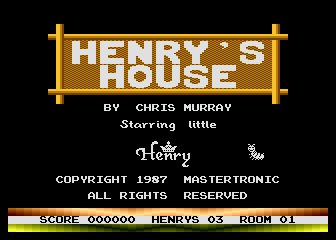
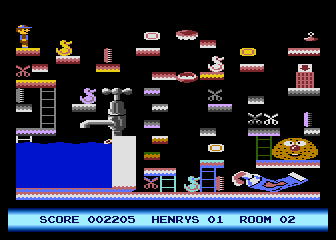
Q: We are here of course to talk about your stunning A8 games. I'd like to start with Henrey's House (AKA Home Sweet Home). The game is often now rolled out as a flagship example of not only being great use of the A8 hardware (chunky but colorful visuals, etc) but also as an example of how an 8-bit platformer should be.
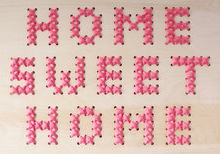
Christopher Murray: Yes, it was called Home Sweet Home initially and hence the original wooden background. This is why the title screen looks a bit odd - it was based on one of the Home Sweet Home stitching thingies and never meant to say Henry's House.
The publisher (English Software) of the C-64 (first) version wanted to take advantage of the fact Charles and Diana had just had Prince Harry, so they suggested renaming it. They actually sent a copy to Buckingham Palace (and a C-64 I think) and we got a response, although they were not permitted to advertise that.
Q: The level design was superb (imagination put to great use in terms of layout, enemy sprites, etc) but also the attention to detail in terms of the challenge it put to the player (pixel-perfect jumps, split-second timing, etc). The player never felt unfairly challenged, and you made great strides to reward the player; you really wanted to get to next room to see the wonders within, and once you lost all 3 lives, you were never sent back to the beginning, but got to continue in last room you were in. The small touches like this really made for a flagship example. Were you, in effect, designing the sort of game you wanted - something to 'show of' your coding skills and something you knew would be fun for everyone to play?
Christopher Murray: No, I wasn’t trying to show off my coding skills per se. I was just trying to create a game that was challenging and exploited the machine until I 'ran out of memory'. A decent platform game appeared to be missing from the Atari; the Spectrum had Manic Miner and I wouldn’t get away
with doing Donkey Kong ;-). I basically went from room to room in my house looking for inspiration. My mum’s Kenwood Chef mixer, toaster, and tin opener really did look like the one you see in the ‘kitchen’ room.
Because it took so darn long to load some of these cassette games, I disliked games you could not finish or see all screens unless you were Superman. So, I didn’t think you should ‘go back to the beginning’ when you had gotten so far. I also didn’t like games that were huge with rather faceless levels, and preferred to make less levels which were prettier/more specific. As you probably know, I usually put a cheat code in my games for those that just couldn’t do it, even with 3
lives, to give them a chance one day to get to the last screen.
Doing graphics was a bit tricky back then, even though I am pretty good at art myself. I wrote my own tools and used a Koala Pad a lot. The A8 hardware has some obvious color and sprite limitations, but I liked to try to push the machine beyond its normal limit; the machine does have some tricks up its sleeve if you are prepared to put some effort in.
If I had the time, I’d probably redo Henry with about 20-30 ‘rooms’ with increasing difficulty, have a proper ending with some cut-scenes, and make it run on Android and iPhones ;-)
Q: How does it feel to see your game so fondly remembered to this day?
Christopher Murray: It's great to create something that so many people enjoyed. My brother once sent me a picture of his 10-year-old daughter playing Henry’s House on an A8 emulator, which was nice, but it does make you feel old!
I have a lot of fond memories of the computer scene in the 80s and early 90s. I once went back to school after I had left. I was about 17, and I took my C-64 with Henry’s House, to show my same Physics teacher who introduced me to the Apple II. I didn’t know, but he had a Registration class in his Physics room, and lots of children ended up playing Henry’s House that lunchtime. It was great fun seeing them laugh, and quite a weird experience for a 17-year-old to see other
children enjoying something you created. I still cherish that moment.
Q: Henry's House seemed more 'suited' to the A8, than the C-64 (such as having more colors available). It's also been claimed that you made more money from the A8 version than the C-64 version, despite the A8 user base being a lot smaller than the C-64, and the A8 scene being blighted as it was by piracy. Do you think being there were so few software houses supporting the A8 and even less quality software to choose from helped your games stand out? And is there any truth to the claim that you'd visited game stores and moved your games to the number.1 selling title spot? That would be creative marketing at its best :-).
Christopher Murray: Well, the (final) Atari version was 3 years later and the ‘second time around’, and I did attempt to refine some things like the character motion and graphics, partly to show the Atari could do more than a lot of A8 games were content with.
Yes, I did make more money from the A8 version, although I did not think I would; the C-64 sold for a lot more money, and I allegedly got £1/unit, whereas the Atari one sold for £1.99 and I got 10p/unit. Nevertheless, the Atari one shot up the charts and stayed there for quite a long time. The sad thing was, I never knew there was a stash of royalty checks sitting at home at my mother’s house, as I had gone to Edinburgh University to take Computer Science. I was quite hard up
(for money), until I went home one end-of-term and realized it’s a mistake to have your royalty checks sent to your mum’s address!
Yes, there were definitely less people coding on the A8 in the UK than say the Spectrum and C-64. I suppose it did help my games stand out, although my C-64 games stood out as well.
Creative marketing - yes that was true. John Menzies, Virgin, and Smiths used to carry my games, and it just seemed (to make) good sense to do some cassette prioritization :-)
There was certainly a lot of piracy of cassette games. People could rent a game and simply copy it on a twin tape deck, which worked for most titles, until the high speed loaders and physical verification systems came along. One thing the A8 Henry’s House taught me is, there is a price point people are prepared to pay - e.g. if it's £1.99, they will just buy it and not copy it, and you probably will make more money than the £5.95 game.
I’ve recently been asked about a Henry’s House reboot by a couple of people; if there’s time, I will.
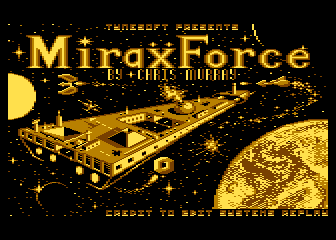
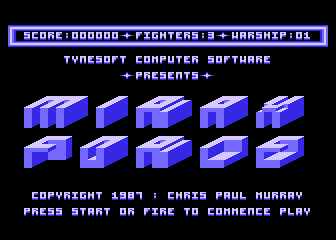
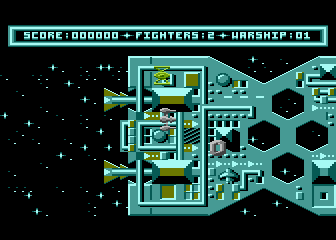
Q: Ok, lets move onto Mirax Force, one of the far-better attempts to bring an Uridium clone to the A8 hardware, the playability of which was only improved by the technical achievement - great speech (your voice I believe), superb use of color, and some fantastic personal touches. It seemed you again wanted to showcase not only what could be done on A8, but also how it should be done. What are your memories of the game and how it came about, and was it really coded in 11 days?
Christopher Murray: Yes, it was an attempt to do something like Uridium on the A8 and push the machine a bit. Having both a C-64 and A8, I sometimes felt frustrated there were no equivalent games on the A8 and took a stab at coding a horizontal scroller.
I did code it in 11 days (56.5 hours in fact - I used to log how much time I spent coding), but I had previously experimented with the speech digitizer, learned how to do smooth horizontal scrolling, and used display list interrupts to split sprites into more than four, so I had those techniques in my arsenal ready to apply.
It was not a complex game to code, apart from the split sprites and collision routing, but then the speech took a lot of memory, which prevented me doing much more. In retrospect, while the game looks/sounds good, I made the game too hard - especially hitting objects on the mothership. I think fending off the alien ships would’ve been enough, or at least being able to blow up the objects on the ground. I do have the source code somewhere…
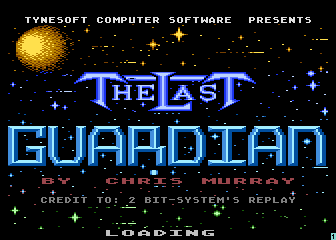
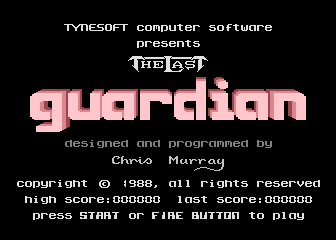
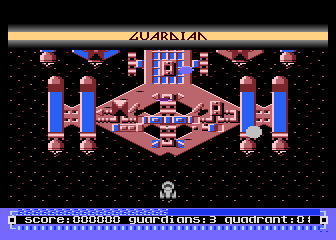
Q: Some claim The Last Guardian was a sequel to Mirax Force. Any truth in this, and why another shooter? Basically at this point, were you (still) creating the games for A8 you wanted, or was it more case of the publisher saying, we need such-and-such game, what can you do for us?
Christopher Murray: Yes, it was a sequel and I wanted to make it (the only games I was asked to work on by publishers were Winter Olympiad and Superman). I wanted to flip the game around and make it a bit more complex and actually give you a fighting chance of NOT dying in Guardian. Basically, I was trying to make a more polished shooter, so I spent quite a bit of effort on the graphics, added the asteroid fields, weapon powers-ups, different alien ship attack patterns, etc.
Q: How was the A8 hardware to work with, as many, while loving the fast CPU and wide range of colors to choose from, found its P/M graphics limitations, compared to a computer like the C-64, something of a headache. Also, the Pokey sound chip, while very flexible, often seemed more suited to sound FX than music (compared to the C-64's SID chip). I only ask as while your games had great, crunchy sound FX and speech in some cases, there was often no in-game music. Was this due to a technical reason, or did you just lack someone to write the music for your games?
Christopher Murray: I didn’t really find it that frustrating. Yes, some things were easier on the C-64 ,but as I showed in Mirax and Guardian, you can use some tricks to get more than 4 sprites and still have colorful ones.
Music was really just an afterthought, and while there were some cool SID tunes that emerged on the C-64, the A8 chip was more suited for sound effects and white noise! Frankly, I thought people would think it would be cooler if the game had speech or cool explosion noises; music didn’t do much for me in games back then. These days, of course, you have armies of people working on games and orchestras on the music.
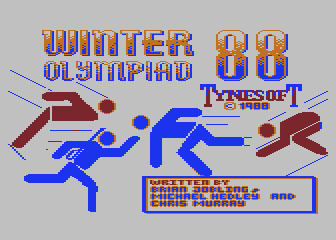
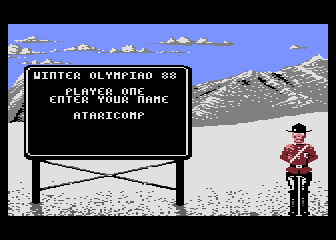
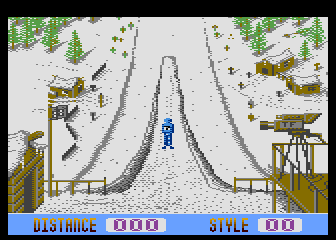
Q: Winter Olympiad '88 seemed to comfortably fill the game that was created by Epyx's proposed Winter Games A8 version never appearing (if my memory is correct, there was so much claimed about what was planned for A8 that ended up being vaporware, it's hard at times to separate truth from fiction), yet I swear I've seen you refer to it as 'ropey'! Were you not a fan? I gather you were part of a team on this one; what was your role?
Christopher Murray: I was basically asked to help out by Tynesoft on the C-64 version. I didn’t mind doing the bobsleigh, and had some fun making trees zoom around, and some parallax scrolling. I’m not sure what happened to the A8 version, but there are some wacky stories about Tynesoft if you do your research :-)
Q: Tynesoft, along with English Software, US Gold, Firebird, Zepplin, and Mastertronic, seemed to be the few, key A8 supporters of the era in the UK. We had token support from Ocean, System 3, etc - far more often claiming games were coming than ever starting them. Do you recall any thoughts about being one of the best A8 coders in the UK at the time, and were there ever any job offers you had to turn down or A8 games you would have liked to have attempted?
Christopher Murray: I turned down a few, mostly because of University commitments and wanting to do my own thing.
A8 games I would have liked to have attempted? I haven't thought about that, although I do wish I had finished Doomsword (more below). I also muse sometimes about creating an A8 game for the retro gamers out there or rebuilding Henry’s House with new levels.
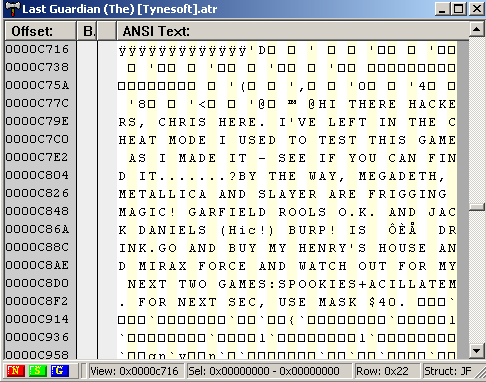 Q: Moving onto lost games, what ever became of Acillatem and Spookies? These were both mentioned on the original The Last Guardian disk. Were there
any other lost games (in any format) you've worked on over the years?
Q: Moving onto lost games, what ever became of Acillatem and Spookies? These were both mentioned on the original The Last Guardian disk. Were there
any other lost games (in any format) you've worked on over the years?
Christopher Murray: I used to put secret messages on spare sectors of my floppy discs, and although it took 20 years for people to notice, you noticed. Spookies was my clone of Ghosts ’n Goblins on the A8 which I later named Doomsword. I wanted to see if I
could code a proper 'software sprite’ system and get way beyond the machine sprite limit. Doomsword only had one working level. It was my first dabble with software sprites on the Atari and I had the main character and the swords working. I remember thinking the 8-bit was handling it easily and we could have shed-loads of sprites this way. I have the floppy but no idea if it will load - need to get some kit to try. It was last 8-bit thing
I was working on before I got sucked into University (this was about 1987) and playing on their UNIX boxes.
Acillatem was going to be another shooter but I never got it off the ground.
Q: For many of us, after the A8 died, you sadly seem to have disappeared from the public eye. Could you talk us through your career post-A8. Didn't you go on to work on the Acorn 3000/ARM chips, and were later involved with the Grand Theft Auto games?
Christopher Murray: Yes, two things made me leave the 8-bit scene. Not so much the emerging Amiga/ST, but University exposed me to UNIX, servers, workstations, and networking, which I loved playing with. I did a bit too much hacking at Uni, but learned a lot. I also won an Acorn Archimedes RISC-OS machine
from a competition ran by a magazine called ACE, which sent me down the Archimedes path for a while.
The Archimedes was in a league of its own at the time; Windows 2 looked pathetic in comparison. I couldn’t stop coding on it, and ended up working for Computer Concepts, Acorn, and a few other Archimedes publishers before moving to UNIX and Windows development. There were a lot of talented guys at each of those companies. Sub-pixel anti-aliasing AKA ClearType? Microsoft didn’t invent it; Acorn did it in the late 80s. The Archimedes CPU (ever heard of an ARM chip?)
had a beautiful RISC Assembly language. It was so easy to use, we coded applications as complex as Computer Concept's Artworks entirely in Assembler.
After working for several Archimedes companies, I moved into UNIX/Windows/object-oriented programming at Uniplex and gained a lot of experience there (some great guys and practices there). By then, I had a wide range of skills; UNIX, Windows, from Assembler and device drivers to applications in C/C++, graphics, network programming, and turned contractor - basically do the same, but you get paid better.
In the late 90s, I co-developed what became known as Cisco Secure Access Control Server for Windows after Cisco acquired it - a network access product used by tens of thousands of companies throughout the world - and I’ve been at Cisco ever since. I still work in network access, security, and policy for Cisco, although outside of work I never stopped hacking. I got pretty good at hardware and reverse-engineered my house alarm so I could control it with my own micro-controller
and iPhone app. I also build devices that monitor and remotely control wind turbines and iPad apps to interface to them.
Having a daughter means I get less time to do what I want.
Q: Do you miss being a 'public figure' as such, and do you feel the games media of today, obsessed as they are it seems with only interviewing the big names of the era, have past you over? Or have you been interviewed before regarding your A8 work? I used to read and love the retro section of gamesTM, but never saw much, if any, reference to the A8.
Christopher Murray: I was certainly never a ‘public figure’ or had ‘public’ fame. In fact, you were considered a geek (not a cool word back then) if you had a computer in the early 80s and locked yourself in a room with it! There are/were a lot better games than mine - Dropzone and Elite stood out for me - but then I’m fairly proud of what I did as a teenager without any help, hardly any resources, and no libraries or SDKs to draw upon.
Q: Finally, any messages for your legions of fans out there, Chris? We as A8 gamers owe you a great deal, and it's been my humble pleasure to be able to put questions to you.
Christopher Murray: Thanks for the kind comments, support, and allowing an old fart to reminisce.
| GAME | SYSTEM | COMPANY | STATUS |
| Henry's House | Atari 400/800 | Mastertronic | released |
| Mirax Force | Atari 400/800 | Tynesoft | released |
| The Last Guardian | Atari 400/800 | Tynesoft | released |
| Winter Olympiad 88 | Atari 400/800 | Tynesoft | released |
| Doomsword | Atari 400/800 | not completed | |
| Acillatem | Atari 400/800 | not completed |